What is Basil?
Basil is a culinary herb that belongs to the mint (Lamiaceae) family. It is believed there are as many as 150 cultivars of basil, but true basils belong to the genus Ocimum. Most culinary basils are a cultivar of sweet basil (O. basilicum) and are used in cuisines throughout the world.
Basil is a tender plant that can be grown as a short-lived perennial in tropical and Mediterranean climates, but is most commonly grown as an annual. It is native to tropical and subtropical regions of India, Africa, and Southeast Asia; however, it is now cultivated globally.
Some varieties of basil have been cultivated for thousands of years. Since basil cross pollinates quite easily, a wide variety of hybrids have emerged with flavors ranging from bold and spicy to mild and sweet. This range of flavors has made basil an indispensable herb in many kitchens world-wide and a majority of global cuisines.
This variety of flavor profiles allows dishes to maintain their traditional taste or give a unique signature to any dish by substituting a different kind of basil. Basil is also a relatively easy herb to grow in a container or as part of a summer garden, which makes it easy to have a selection of basil plants available for any type of food being prepared. And what could be better than freshly harvested basil for that special recipe?
Kinds of Basil
Sweet Basil
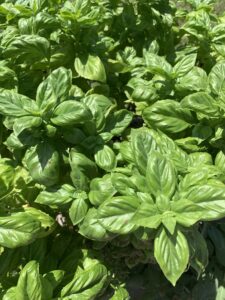
Sweet basil is probably the most commonly used and easily found basil of the different kinds available. This is the kind of basil carried in most grocery stores. Sweet basil is a medium green color and has an oval, cup-like shaped leaf.
How to Use
Sweet basil is used in Italian and Asian cooking. It is also a main ingredient to most pestos, Caprese salad recipes, and stir fry dishes. But don’t let that limit how you use this wonderful treat! It plays well with all sorts of dishes from appetizers to deserts. Here are some simple suggestions:
- Blend into sauces for a punch of flavor
- Use as a tasty garnish
- Add to a salad for a little zest
- Toss whole or cut leaves into cooked pasta to add pizzaz
- And of course, pesto! Pesto freezes well and keeps the flavors of summer alive all winter to keep away those winter blues.
Recipes
Try these amazing recipes for more inspiration using sweet basil!
Grow Your Own
Sweet basil is perfect for a container garden in the window or patio, but needs to stay well watered or the leaves will wilt. Sweet basil needs full sun and likes hot weather. If planting outside make sure it is after all danger of frost is over. It should also be harvested prior to the cooler temperatures in fall.
Needing more basil? Harvest your sweet basil frequently and it will just produce more! All that basil you harvest over summer won’t go to waste if you dry it or freeze it to have over the winter months. Dried basil doesn’t have the same intoxicating fragrance as fresh, but does work well added to foods while cooking.
Mature plants reach a height of about 18 inches and a width of about 12 inches.
Did You Know?
- “Basil” is suspected to have evolved from the Greek basilikon phyton, which means “royal plant.”
- Basil is the most familiar of all herbs.
- It is believed that basil if one of the 130 herbs used in making the liqueur Chartruese.
- Basil was found in Egyptian mummies because it was used in the embalming process.
Genovese Basil
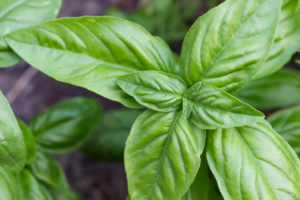
Genovese basil is a cultivar of sweet basil that originated in Genoa, Italy. It has a similar flavor profile to sweet basil, but is more aromatic. Reminiscent of its cousin, Genovese basil flavor has a hint of mint and clove, while also having a peppery and spicy tinge as well.
The leaves of Genovese basil are more pointed at the ends and are flatter than the cup-like leaves of sweet basil. The leaves are a deeper green and shiny compared to sweet basil.
Genovese basil is often the preferred sweet basil due to its large leaves and that it tends to not become bitter as the plant ages.
How To Use
Genovese basil can be used interchangeably with sweet basil.
Recipes
Try these mouth-watering recipes using Genovese basil!
Grow Your Own
Genovese basil, like other basils, likes rich, fertile soil, plenty of sunlight, and constant moisture to its roots. Be sure your garden soil is well amended or use good, quality potting soil for containers. Genovese basil is perfect for containers, but heavy use of fertilizers can affect the flavor, scent, and potency of the plant.
Genovese basil will form full, bushy plants if pinched back often. This frequent pinching back keeps the plant from forming flower spikes and will keep it producing those beautiful, tasty leaves. Once it begins to produce flower spikes it will then put all its energy into flower production for seeds and not continue growing leaves.
If your plant does begin to form flower spikes it’s not the end of the world – at least your basil world! The flower spikes can also be used as you would the leaves. Use the flowering portion of the plant sparingly though since the flower spikes have a much more concentrated flavor.
Mature plants reach a height of about 18-24 inches and a width of about 10-14 inches.
Did You Know?
- Genovese basil was used in window boxes or sill pots to keep flies out prior to the use of window screens.
- “Pizza Margherita” was invented by Raffaele Esposito in 1889 in honor of the Queen of Italy, Margherita of Savoy, and the Italian unification. The red pizza sauce represented the red of the Italian flag, the mozzarella cheese the white of the flag, and the basil leaves the green of the flag.
- Caprese salad is believed to have been created just after the end of World War I when an Italian stone mason wanted to pay homage to his country and used tomatoes, mozzarella, and basil together to represent the tricolors of the Italian flag.
Thai Basil
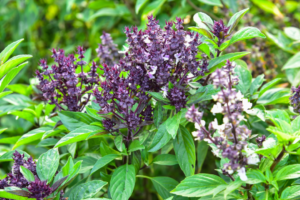
Thai basil is often also referred to as Sweet Thai. This basil has a spicy flavor with hints of anise, licorice, and clove. Thai basil is native to Southeast Asia and used frequently in cuisines from this area including Thailand, Cambodia, Vietnam, and Laos.
The leaves of Thai basil are small and narrow with serrated edges and branch off purple stems. The flower spikes of Thai basil are a purplish-pink. This lovely coloration makes it a favorite not only for cooking, but also as an ornamental plant in beds.
How To Use
Thai basil is often a staple ingredient of red and green curries. While holy basil is the basil of choice for many chicken, pork, and seafood dishes in its Asian homeland, Thai basil is more readily available in the West and used instead.
Thai basil is also used to infuse flavor into vinegar and oil, making tea, or as a substitute in pesto. It also pairs well with a variety of foods including: fruits (mango, pineapple, watermelon, lemon, and figs), meats (chicken, beef, and shrimp), and as an aromatic in cocktails and beverages. It is usually used fresh, but can be chopped and frozen for up to two months.
Recipes
Here are some tasty suggestions for you!
Grow Your Own
Thai basil seedlings can be found in plant nurseries, but are also easily started from seed. These plants, like other basils, like full sun, warm temperatures, rich soil, and moist (not wet) roots. Try to keep water off the leaves as they will yellow and fall off if over watered.
Thai basil leaves bruise easily so take care when planting and harvesting. These plants are more compact than other types of basil so harvest leaves from the top of a group of leaves so the stem doesn’t rot.
Allowing Thai basil plants to flower will cause the leaves to become bitter tasting so should be pinched back when beginning to flower. The continual pinching back will encourage regrowth and keep you supplied all season.
Mature plants reach a height of about 12-24 inches and a width of about 12-24 inches.
Did You Know?
- In Southeast Asian countries, Thai basil is generally considered a vegetable rather than an herb.
- In Vietnam, Thai basil is known as Rau Huue, which translates to “cinnamon mint.”
- Thai basil withstands heat better than other types of basil.
- Thai basil is often used as a condiment so it can be adjusted to each individual’s taste.
Spicy Globe Basil
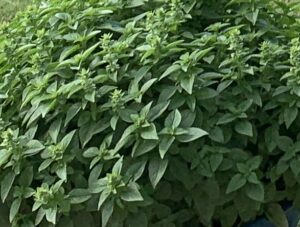
Spicy Globe basil is also known as Spicy Bush or Boxwood basil. It grows in a compact, round shape and is ideal for a container herb garden or growing indoors in winter.
Spicy Globe basil has a bold, spicy flavor. It’s small leaves have a bright green color and are perfect for serving whole in soups, salads, and pastas for an added zing of flavor.
How To Use
Spicy Globe basil is perfect for infusing vinegars or adding a punch to salads and sauces. It also adds a burst of flavor to any Italian, fish or meat dish. Try sprinkling a few leaves over fresh fruit for a refreshing summer desert.
Like most other varieties of basil, Spicy Globe basil can be frozen or dried.
Recipes
Grow Your Own
Spicy Globe basil grows in well-draining soil, but the roots need to stay moist. Like other basils, it doesn’t like cold and needs to be brought indoors to over-winter. Spicy Globe basil likes full morning sun and more shaded conditions for the afternoon heat. It should be fertilized with a general fertilizer mixed at half strength.
Mature plants reach a height of about 8-12 inches and a width of about 6-12 inches.
Did You Know?
- In many cultures, basil is a symbol of love.
- The Greeks and Romans believed basil represented hate and misfortune.
- English royalty favored basil and it was used in culinary and cosmetic applications. This is one reason chefs refer to it as “the king of herbs.”
Cinnamon Basil

Cinnamon basil is also know as Mexican Spice basil. It gets its name from its aroma and taste that is similar to cinnamon spice. The leaves are quite narrow compared to other kinds of basil with slightly serrated edges. Coloring of the leaves can range from a light green to a dark green with purplish veining and dark purple stems. The flower spikes of cinnamon basil are purple with pink, lavender, or white blooms. These plants will bloom from July to September if not pinched back.
How To Use
Cinnamon basil’s cinnamon-like flavor enhances both, savory and sweet, dishes. It can be used to infuse flavor into vinegars, oils, syrups, and honey. The leaves can be torn or chopped for use in salads, sprinkled over soups, and blended into pestos, marinades, and pastas.
It is also a wonderful addition when cooked into apple sauce, jams and jellies, and sauces. It adds unique flavor to baked goods like cookies and pies and pairs nicely with fresh fruits including oranges, melons, kiwis, limes, apples, and strawberries. Cinnamon basil also nicely complements meats. It can enhance the flavor of pork, poultry, ham, and beef.
In Mexico, cinnamon spice is often added to cocktails. It is infused into mojitos, mixed into mezcal-based drinks, and as an ingredient in canelazo, a hot spiced rum drink similar to a hot toddy. It is also a frequent addition in Indian and Asian cooking.
The flowers make a lovely garnish for soups, desserts, salads, roasted meats, ice cream, and cocktails.
Recipes
Grow Your Own
The easiest way to grow cinnamon basil is by purchasing seedlings from a nursery, but depending on where you live, it might be difficult to find seedlings in the desired cultivar. Fortunately, seeds of different cultivars are typically fairly easy to find and can, most certainly, be ordered from online.
Whether starting from seed in the garden or planting seedlings, wait until after the last frost if planting in the ground. Start seeds in starter pots four to six weeks prior to the last frost to have a nice head start on your herb garden.
Cinnamon basil, like other basils, needs full sun and well-drained soil. These plants can grow quite large (close to 3 feet in height and width) so need plenty of space. Frequent pinching back will encourage branching out to form full, bushy plants.
Cinnamon basil leaves will grow bitter if the plant begins to form flower spikes so keep the plant pinched back. Individual leaves or stems can be harvested, just be sure to leave three sets of leaves on the stem at a minimum to ensure the health of the plant. Frequent pinching back helps the plant to remain healthy and producing more deliciousness for harvest.
Mature plants reach a height of about 26-30 inches and a width of about 36 inches.
Did You Know?
- “Cinnamon basil” can refer to several types of basil, including: a cultivar of sweet basil, Thai basil, and as a cultivar of Thai basil.
- Cinnamon basil seeds were taken into space on the Space Shuttle Endeavor and grown on the ISS as part of a research experiment.
- Cinnamon basil is also used in dried floral arrangements and potpourri.
- Cinnamon basil is a source of vitamins C, K, and A and provides small amounts of iron, potassium, and magnesium.
Lemon Basil
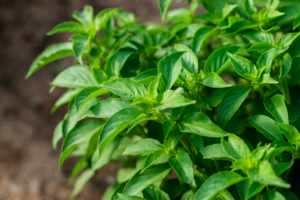
Lemon basil is a hybrid creation of sweet basil and American basil. It combines the sweet, mellow basil flavor with a lemony citrus zing. Lemon basil has been growing wild in Asia, where it is believed to be a native plant, since archaic times. It was highly cultivated in Southeast Asia for the delicate flavor and became a central ingredient to Asian cuisine and is the primary basil variety used in Laos cuisine.
Lemon basil leaves are on the smaller side compared to other basil varieties and have an oblong shape that is pointed at the end. They grow in pairs on each side of a box-shaped fuzzy stem and are a bright green color, smooth and flat with some veining, and have slightly serrated edges.
How To Use
Lemon basil enlivens the flavor of seafood, meats, vegetables, rice and pastas, salads, and baked goods. The citrusy goodness bolsters dips, vinaigrettes, and beverages alike. An infusion of lemon basil adds new dimension to oils and syrups. Thin slices sprinkled over fresh fruit makes for a refreshing summer dessert.
Lemon basil pairs well with a variety of aromatics, including ginger, garlic, chives, and mint. It also complements many cheeses such as mozzarella, feta, parmesan, and blue.
Recipes
Grow Your Own
Lemon basil, like other basils, likes warm weather and moist, well-draining soil. It needs to be planted after the last frost, but seeds can be started indoors a few weeks before the last frost. Seeds will typically germinate within eight to fourteen days. Seedlings can be transplanted once they have at least two sets of true leaves. Mulching around the plants helps to keep them warm, prevent weeds, and maintain moisture.
Lemon basil plants should be pinched back often to prevent them from becoming too leggy. Frequent pinching back encourages the plant to branch out and become bushier. Flower spikes should be pinched back to keep the leaves from losing their flavor. However, the flowers can be used as garnish and to flavor foods as well.
Mature plants reach a height of about 36 inches and a width of 24 inches.
Did You Know?
- Lemon basil plants are becoming much easier to find at local garden centers and nurseries with its rising popularity.
- Mrs. Burns’ and Sweet Dani are two varieties of lemon basil favored for their intense lemony aroma and flavor.
- Lemon basil is also known as hoary basil, Lao basil, or Thai lemon basil.
- Lemon basil was brought to the Americas in the 17th century.
- Lemon basil is an excellent source of beta-carotene; it is also a good source of vitamin K.
Dark Opal Basil
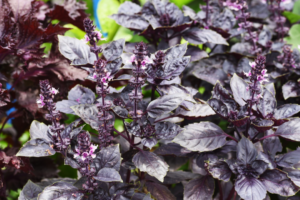
Dark Opal basil has coloration ranging from dark purple, burgundy, and green; a mottled coloration is quite common. The leaves range from a small to medium size with an oval shape that tapers to a point on the end. They also have a crinkled appearance and an iridescent sheen in the sunlight.
Dark Opal basil has a spicy aromatic scent reminiscent of cloves while the leaves have a sweet but savory flavor of ginger, cinnamon, clove, mint, and anise. The flowers are small with a purplish-pink coloring and a mild, sweet flavor.
How To Use
Dark Opal basil is a wonderful addition of color and flavor when torn and added to salad greens. The whole leaves are an attractive addition to a charcuterie board or roughly cut and tossed into pasta and stir-fry dishes, curries, soups and stews, or blended into sauces and pestos.
The lovely coloring of the leaves make it a natural choice for flavoring and coloring when infused into oils and vinegars. The leaves can be steeped into a tea or substituted for sweet basil in recipes. Dark Opal basil pairs well with many vegetables, cheeses, and aromatics.
Recipes
Grow Your Own
Dark Opal basil can be grown from seed or propagated from cuttings. Germination time for seeds is between three and fourteen days and should be placed in a partially sunny spot when just sprouting and through leaf development. Seedlings should gradually be exposed to full sun as they mature.
Dark Opal basil grows more slowly than other types of basil. Begin pruning once the plant is several inches in height and has developed a few leaf pairs. Pinching back young plants encourages branching and encourages growth for more attractive mature plants.
Once the plant is allowed to form flower spikes the leaves tend to become bitter, but the flowers make a nice garnish for soups, salads, and main course dishes.
Mature plants reach a height of about 18 inches and a width of about 18 inches.
Did You Know?
- Dark Opal basil was developed at the University of Connecticut in the 1950s.
- Dark Opal basil can be grown with tomatoes to encourage growth and help repel pests.
- Dark Opal basil grown near outdoor seating areas or in containers on decks helps repel mosquitoes and other stinging insects.
- Chewing the leaves of Dark Opal basil helps relieve nausea and flatulence.
Napoletano Basil
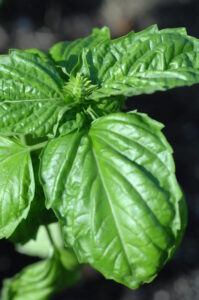
Napoletano basil is commonly known as Italian Large Leaf basil or Lettuce Leaf basil. The large leaves are a light green and crinkly in appearance. The leaves are quite large measuring almost three inches wide and five inches long. Napoletano basil has a traditional basil flavor, but is milder and sweeter than its Genovese basil cousin.
How To Use
Napoletano basil’s sweet, spicy flavor makes it perfect for a variety of culinary uses. It can be substituted in for any recipe using sweet basil. The large leaves are ideal for making wraps filled with mozzarella and tomatoes or meats like fish and poultry. Its sweet, savory flavor complements soups, sauces, vegetables, pastas, dressings, and marinades.
Recipes
Grow Your Own
Like other basils, Napoletano basil wants warm temperatures, moist, rich soil, and lots of sun. It should be harvested frequently to encourage more leaf production. Basil is frost sensitive and should be harvested completely by the first frost.
Mature plants reach a height of about 18 inches and a width of about 18 inches.
Did You Know?
- Napoletano basil is referred to as “bolloso” in Italy due to its crinkly or blistered appearance.
- Napoletano basil originated in Naples, Italy.
- Napoletano basil has the largest leaves of all the basil varieties.
- Napoletano basil is a good source of vitamin K, A, and C along with calcium, magnesium, iron copper, and folate.
Greek Basil
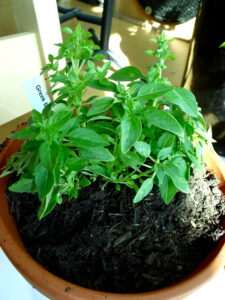
Greek basil is originally from the Middle East region, but found its way to the Mediterranean area where it grows very well. This basil is compact in size growing to a height of about eight inches. Its small, pointed leaves grow in a compact, bubble shape and have a bright green color.
How To Use
Greek basil has a delicate flavor making it very versatile. It makes a wonderful addition to salads, soups, meats, and eggs. It is often the basil of choice for tomato dishes.
Recipes
Grow Your Own
Greek basil is an ideal choice for a container garden. Its compact size and low maintenance requirements make it an easy addition even for beginner gardeners. Plants will reach maturity within 60-90 days.
Mature plants reach a height of about 18 inches and a width of about 18 inches.
Did You Know?
- Greek basil is a natural source of vitamins and antioxidants.
- Greek basil grows wild in Greece.
- Greek basil was first sold by Burpee Seed Company in 1908.
Green Ruffles Basil

Green Ruffles basil is a showy basil variety. Its large, deep green, ruffled leaves not only taste delicious, but add a beautiful visual element to your herb garden. Green Ruffles basil has a mild yet complex taste with hints of anise, cinnamon, citrus, and spice. The delicate flavoring of Green Ruffles basil makes it a delightful addition to any recipe calling for basil.
How to Use
Salads, pastas, pestos, or any dish using basil as an ingredient are enhanced by the addition of Green Ruffles basil. The frilly leaves also make a pleasing garnish for presentation of recipes.
Grow Your Own
Green Ruffles basil, like other basils, requires warm temperatures, rich, moist soil, and full sun. Harvest prior to the first frost since it is frost sensitive. Seeds can be started indoors a few weeks before the final frost of the season to get a jump on the growing season.
Mature plants reach a height of about 24 inches and a width of about 16 inches.
Did You Know?
- Green Ruffles basil leaves measure an astounding 4-6 inches long.
- Green Ruffles basil in a variety of Lettuce Leaf basil.
- Purple Ruffles basil is a hybrid of Dark Opal basil and Green Ruffles basil.
- The flowers of Green Ruffles basil (like other basils) attract bees and other pollinators.
Storing Fresh Basil
Regular pinching back of basil plants to encourage branching and to prevent flowering can leave you with an over-abundance of a good thing! And who wants to let all that wonderfulness go to waste? The good news is that it’s not difficult to keep all that basil for use throughout the year.
Short-Term
Fresh basil can last up to about 10 days when stored properly. Just be sure the basil is dry before storing and DO NOT wash before storing. The leaves will turn dark if there is any moisture present. Don’t store in plastic wrap for this reason.
The best way to store fresh basil is to put the harvested stems in a vase of water as you would cut flowers and keep on the kitchen counter out of direct sunlight. Change the water every few days.
If you want to store your basil in the refrigerator, store it as you would salad greens. Using a salad spinner to dry the leaves is a good option and they can be stored in the spinner bowl. They can also be placed in a container loosely packed in layers. An herb keeper is another good option.
Freezing
The first, obvious choice is to make up some batches of your favorite pestos for freezing. Nothing says summer like a dollop of pesto in some soup or stew on a cold, dreary day. Filling some mini ice trays with your freshly made pestos, freezing them, and then removing to a freezer bag gets your pestos ready to go for your winter bite of summer sunshine!
Basil leaves can be frozen so they can be used in recipes as well. Blanch the leaves for a couple seconds in boiling water, then drain and rinse in cold water. Gently dry the leaves and place in layers separated with plastic wrap into a freezer container. Use your frozen leaves as you would when fresh. The frozen leaves have a more concentrated flavor so reduce the amount slightly from the amount you would use when fresh.
Another method of freezing basil leaves is to place them in a freezer bag without blanching. The frozen leaves will be quite brittle and can be crushed individually or in the bag. Be sure the leaves are dry or they will freeze together. If you are worried about them freezing together they can be frozen individually on a cookie sheet and then placed in a freezer container
Drying
Drying your basil is an obvious choice and probably the most popular method. Originally, basil was gathered into small bundles and hung upside down to dry. This is plainly inefficient since most of us no longer have root cellars or want to look like the local town witch doctor with herbs hanging from the ceiling in our kitchens. Fortunately, there are several more efficient options.
An easy and efficient way of drying your basil is using a dehydrator, warm oven, or microwave. Laying your basil leaves out on an herb drying rack is a little less efficient for space and time, but still effective.
Once the leaves are dried, crush or grind them using a mini food processor or an herb grinder. When the leaves are at the desired consistency they are ready to be placed into a spice jar.
Dried leaves can have much more concentrated flavor since there is no moisture to dilute the flavor so use sparingly. With that said, dried basil tends to lose its flavor more quickly than frozen basil but still provides a heavenly aroma and flavor to your culinary creations.
Basil is so versatile for cooking it is a natural choice for the herb garden. Thanks to how easy it is to grow and the selection available in garden centers and online, you can have your choice of varieties that will pair well with whatever dish you are preparing. Keeping your basil plants pinched back for healthy growth only makes it easier to enjoy your harvests throughout the year when you preserve them.


